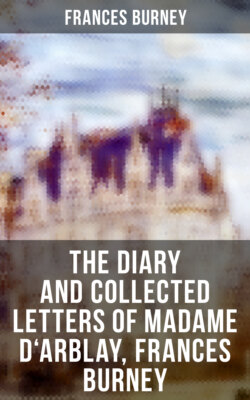Читать книгу The Diary and Collected Letters of Madame D'Arblay, Frances Burney - Frances Burney - Страница 4
На сайте Литреса книга снята с продажи.
(1778) MISS BURNEY PUBLISHES HER FIRST NOVEL AND FINDS HERSELF FAMOUS
ОглавлениеTable of Contents
(Miss Burney’s first novel, “Evelina,” had been submitted in manuscript to the great publisher, Dodsley, who refused to look at an anonymous work. It was then offered to Lowndes, who published it. The negotiations with the publisher were carried on by Fanny’s brother Charles, and her cousin, Edward Burney. These two, with her sisters, and her aunts Anne and Rebecca (Dr. Burney’s sisters), appear to have been the only persons entrusted with the secret. It will be most convenient here, at the commencement of—“The Diary,” to give a few necessary details respecting the Burney family. By his first wife, Esther Sleepe, Dr. Burney became the father of seven children:—
1. Esther (“Hetty”), born 1749; married, in 1770, her cousin Charles Rousseau Burney, eldest son of Dr. Burney’s elder brother, Richard Burney, of Worcester. Hetty’s husband is always called “Mr. Burney” in the “Diary”. He was a musician.
2. James, the sailor, afterwards Admiral Burney, known to readers of “Elia.” He was born June 5, 1750; accompanied the great discoverer, Captain Cook, on his second and third voyages; served in the East Indies in 1783, after which he retired from active service. In 1785 he married Miss Sally Payne, and the rest of his life was devoted to literature and whist. His “History of the Discoveries in the South Sea or Pacific Ocean” is still a standard work. James died November 17, 1821.
3. Charles born June, 1751; died young.
4. “Frances” our “Fanny,” born June 13, 1752.
5. Susanna Elizabeth, the “peculiar darling of the whole house of Dr. Burney, as well as of his heart”—so Fanny writes of her favourite sister. She was born about 1755, and married, in the beginning Of 1781, Captain Molesworth Phillips, who, as Cook’s lieutenant of marines, had seen the discoverer murdered by savages, in February, 1779, and narrowly escaped with his own life on that occasion. Susan died January 6, 1800.
6. Charles, afterwards Dr. Charles, the distinguished Greek scholar; born December 4, 1757. After his death, in 1817, his magnificent library was purchased for the British Museum, at a cost Of 13,500 pounds.
7. Charlotte Ann, born about 1759. She married Clement Francis, in February, 1786. He died in 1792, and she married again in 1798, Mrs. Barrett, the editress of the “Diary and Letters of Madame d’Arblay,” was Charlotte’s daughter by her first marriage.
By his second wife, Elizabeth Allen, whom he married in 1767, Dr. Burney had two children—a son, Richard Thomas, and a daughter, Sarah Harriet. The latter followed the career of her famous half-sister, and acquired some distinction as a novelist. Cousins Richard and Edward were younger sons of Uncle Richard Burney, of Worcester. Edward was successful as an artist, especially as a book-illustrator. He painted the portrait of Fanny Burney, a reproduction of which forms the frontispiece to the present volume. Some of his work may be seen in the South Kensington Museum.
Chesington, where we shall presently find Fanny on a visit to Mr. Crisp, was an old roomy mansion, standing in the midst of a lonely common in Surrey, between Kingston and Epsom. It had belonged to Mr. Crisp’s friend, Christopher Hamilton, and on his death became the property of his unmarried sister, Mrs. Sarah Hamilton, who, being in poor circumstances, let part of the house to a farmer, and took boarders. Of the latter, Mr. Crisp was the most constant, boarding at Chesington for nearly twenty years, and dying there in 1783. Kitty Cooke, whose name occurs in the “Diary,” was the niece of Mrs. Hamilton, and resided with her at Chesington. Mrs. Sophia Gast, whom we find a frequent visitor there, was the sister of Mr. Crisp, and resided at Burford, in Oxfordshire.
Chesington Hall, the name the old manor house goes by in the locality, is still standing, and is a plain brick building with a small bell turret in the roof, but in other respects it has been somewhat modernized since the days of Fanny Burney. The common has been parcelled out into fields, and a picturesque country road now gives access to the front entrance to the house. From the lawn at the back a narrow avenue of venerable trees, which throw out their long arms in strange grotesque fashion, leads directly to the little village church where Mr. Crisp is buried.
